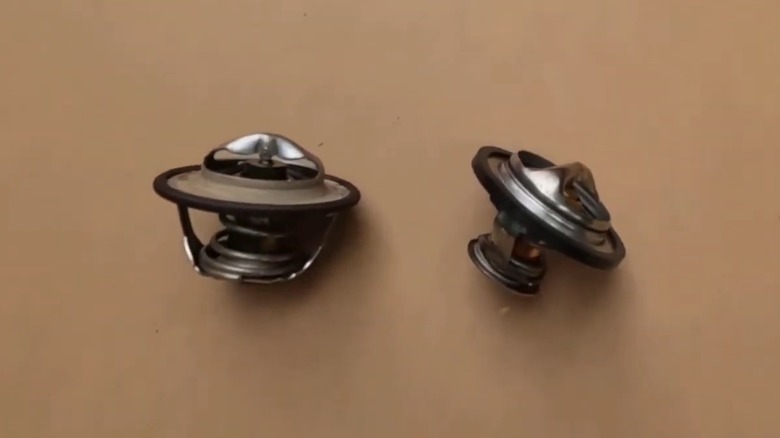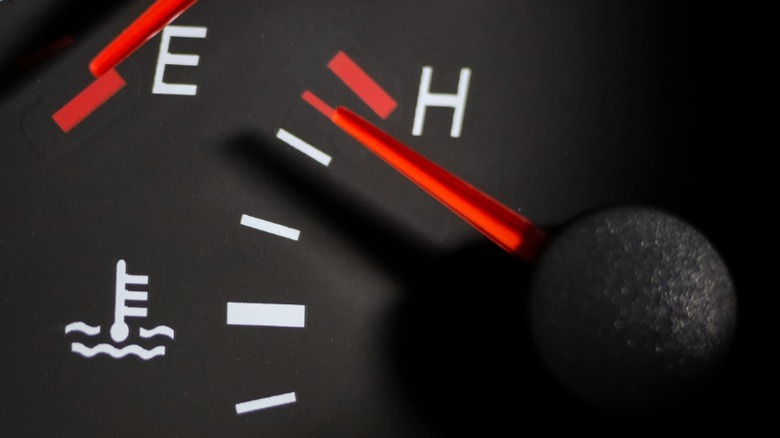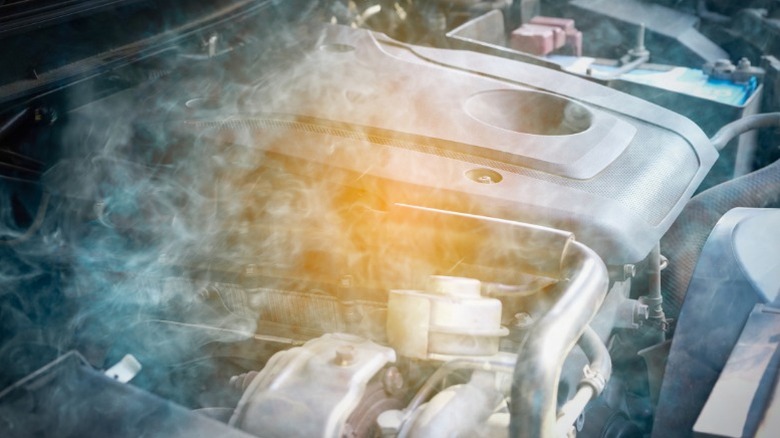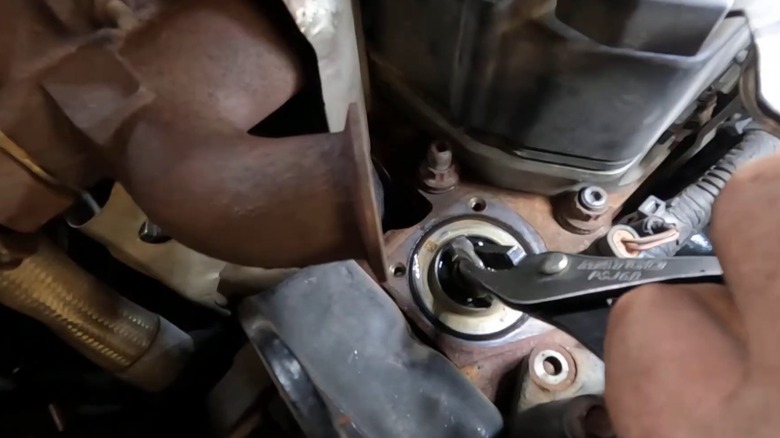5 Signs Your Diesel Engine Has A Bad Thermostat
Internal combustion engines — including those that run on diesel fuel — rely on various systems, accessories, and electronics to keep the pistons moving and your wheels turning. Of those systems and components, the engine cooling system assumes one of the most important responsibilities: helping to ensure that your engine runs at the correct temperature. The cooling system's job is critical, because if your engine runs too hot or too cold, it's likely to develop numerous problems, including everything from reduced performance and poor fuel mileage to complete engine failure. The cooling system itself is complex and relies on many smaller individual parts that work together to keep the engine running optimally, including the diminutive yet supremely important thermostat.
To explain how your engine's thermostat works, let's explore the cooling system in greater detail. The primary parts of the system include a water pump, a network of hoses and fluid channels, a radiator, the thermostat, and coolant. The pump sends coolant, a mixture of antifreeze and water, through the cooling system and the engine. The coolant absorbs excess heat from the engine before traveling back to the radiator, where it sheds that heat.
The thermostat is a small valve that looks somewhat like a spring encased in a cylinder. Its job is to regulate coolant temperature by opening and closing, allowing coolant to return to the radiator, depending on current engine temperatures and driving conditions. As a vital part of your vehicle's anatomy, the thermostat can cause various issues if it fails. As a former professional auto repair technician with years of experience working on gas and diesel vehicles, I'll break down all of the common signs that your diesel engine has a bad thermostat. Let's dive in and check it out.
The dashboard temperature gauge moves erratically
A lot of issues can indicate that there's a problem with your diesel engine's thermostat. However, one of the most common signs of thermostat trouble is a dashboard temperature gauge that moves erratically. Under normal operating conditions — i.e., once your vehicle's engine is warmed up and running properly — the temperature gauge needle should sit somewhere around the middle of the gauge's temperature range. While the exact proper operating temperature will vary from car to car, the mid-level position is generally where you want the gauge to be. However, if the gauge's needle begins bouncing up and down or otherwise moving erratically, there's likely a problem with your engine thermostat.
You're liable to notice this problem if the thermostat fails or has a malfunction because it will be unable to regulate the coolant temperature properly. This issue occurs because the thermostat's job is to open and close, allowing coolant to return to the radiator to cool down. However, over time, automotive thermostats can wear out and develop damage. When that happens, the thermostat may become stuck in its open or closed position, or it may open and close erratically at the wrong times.
If the latter occurs, your car's engine temperature is likely to fluctuate rapidly, resulting in your dashboard temperature gauge's erratic movement. A malfunctioning thermostat isn't the only problem that can cause your vehicle's dashboard temperature gauge to behave strangely. However, it is one of the most likely causes, and if you experience the issue for yourself, you should prioritize getting a cooling system inspection as soon as possible.
You have coolant leaks
Finding puddles of automotive fluids beneath your vehicle is never enjoyable. It almost always means that something is wrong with one of your car's systems or components, causing a leak and potentially making your vehicle unsafe to drive. However, while it's never fun to spot a fluid leak, it can be a useful way to identify vehicle damage, like a bad thermostat.
Automotive thermostats are usually installed between either the upper or lower radiator hose and the engine. Automakers install a gasket between these components to provide a durable seal and prevent leaks. However, over time, these gaskets can degrade and fail. When that occurs, it's common for the thermostat housing to begin dripping coolant. This problem may start out as a very minor leak that doesn't create noticeable puddles of fluid beneath the car. Over time, though, you may lose large amounts of coolant, which can cause your vehicle to begin running poorly and overheating.
If you follow a regular maintenance schedule, you should be inspecting the engine bay regularly. It's a good idea to inspect the cooling system — including the thermostat housing — any time you pop the hood. The thermostat's location will differ from car to car, so you may need to do a bit of research to identify yours. That said, thermostats are usually relatively accessible, and coolant leaks are generally easy to spot. If you notice a buildup of a crusty and colorful substance around your engine's radiator hoses or other nearby parts, there's a good chance you have a coolant leak.
Your vehicle's cabin heating system stops working
Another issue that may allude to a bad diesel engine thermostat is the failure of your cabin heating system. That's because your engine cooling system and your cabin heating system are closely connected. In fact, these systems are so closely related that if there's a problem with the cooling system, the cabin heating system may cease to function altogether. That's because the cabin heating system gets its heat from hot coolant leaving your car's engine.
The cabin heating system works thanks to a heater core located behind the dash, usually on the passenger side. Depending on your car, hot coolant from the engine flows through the heater core at all times or once the heating system is active. When you turn on the heat inside your vehicle, a blower motor sends air across the heater core, allowing the cold air to absorb heat from the coolant stored inside the heater core and warm your car's interior.
What does that have to do with the thermostat? Well, we already mentioned that when an automotive thermostat fails, it may become stuck in its opened or closed position. If it becomes stuck in its open position, then coolant will constantly flow through the system. Because the coolant will cycle continually through the radiator, it likely won't have a chance to get very warm. If that occurs, it doesn't matter whether the heater core is full of coolant or not — if the coolant is cold or lukewarm, the air being pulled into the cabin won't be able to absorb enough heat to warm the car properly. Keep in mind that various issues can cause your vehicle's heater to stop working. So, if you experience the problem yourself, you may want to ask a professional to take a look.
You hear strange sounds from the engine bay
Cars can make a lot of unpleasant sounds when they're experiencing a malfunction. These noises can include everything from squeaks and squeals to groaning, clunking, rattling and more. While never enjoyable, strange automotive sounds, like leaks, can be valuable tools for diagnosing deeper problems. Noises that emanate from the engine bay, in particular, should never be ignored — some of these noises can even indicate problems with your diesel engine thermostat.
If your thermostat is causing strange engine noises, you're liable to hear things like bubbling, rumbling, or hissing sounds. These sounds are likely the result of coolant boiling inside the system and may be caused by a faulty thermostat stuck in its closed position. When the thermostat becomes stuck in its closed position, the coolant will be unable to circulate through the system properly.
That can lead to the development of excess heat and cause the coolant to begin boiling. If your coolant is boiling, you may notice strange sounds, like bubbling, gurgling, rumbling, or hissing coming from the engine bay, and you may also notice steam escaping from under the hood. Various issues besides a faulty thermostat can cause this issue, though, so if you experience it yourself, you should strongly consider visiting a professional repair shop for an inspection.
Your car is overheating
If there's a problem anywhere in your vehicle's engine cooling system, there's a strong chance that you'll experience engine overheating issues. These issues are extremely serious for your car and, as mentioned above, can lead to everything from performance problems and drops in fuel mileage to complete engine failure. A bad diesel engine thermostat is a likely cause of overheating problems, thanks to two potential conditions.
Usually, engine thermostats fail either by leaking around their gaskets or becoming stuck in their opened or closed positions. If the thermostat gasket fails or the housing becomes damaged in some way and a leak develops, you're likely to experience overheating issues due to that loss of coolant. Without an adequate supply of coolant circulating through the engine and cooling system, excess heat will develop very quickly. Alternatively, if your thermostat fails and becomes stuck in the closed position, the coolant won't be able to return to the radiator to release the heat it absorbs from the engine. That is likely to result in the development of extreme heat in the engine, potentially causing the various problems we mentioned above.
If your car's engine starts overheating while you're driving, you should pull over immediately if it's safe to do so. Don't attempt to open the radiator or mess with the cooling system until the vehicle is thoroughly cooled down, and if you're not an automotive expert, you should visit a professional mechanic as soon as possible to avoid further damage.
How much does it cost to replace a diesel engine thermostat, and can you do it yourself?
If you're able to confirm that your diesel engine thermostat is faulty, you may be wondering if it's an expensive part to replace and whether it's something you can do yourself. First of all, the cost to replace the thermostat can vary widely depending on your car's make and model and the shop you visit. In general, you can expect the price to fall somewhere between $175 and $500. However, as mentioned, the price can vary substantially depending on how difficult the thermostat is to access, as well as the cost of the replacement and your shop's labor rates.
While not the most expensive part to replace, it's still a decent chunk of change, and you may be wondering if you can replace your thermostat at home to save some cash. The answer is yes. As mentioned briefly above, many thermostats are easily accessible — replacing the thermostat on some vehicles is as simple as disconnecting a radiator hose and removing a few bolts. However, that's not the case for every diesel engine.
For example, accessing the thermostat on Volkswagen Jettas with a TDI diesel engine requires removing various components. In comparison, replacing the thermostat on a Ford pickup with a 6.7-liter Power Stroke engine only requires the removal of a few bolts. If you're an automotive novice, and especially if you own a diesel vehicle with a difficult-to-access thermostat, you can perform the replacement yourself — you should invest in a repair manual specific to your car, though, or ask a knowledgeable friend to help.






